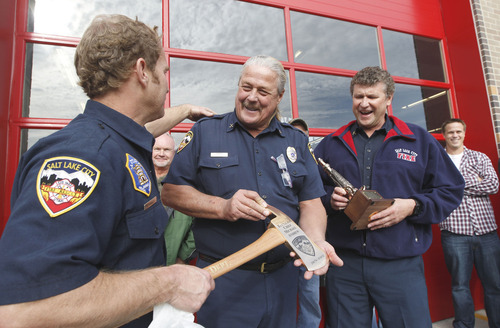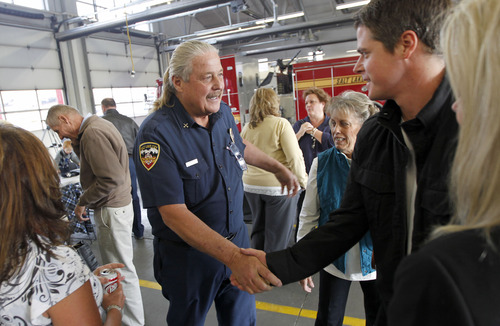This is an archived article that was published on sltrib.com in 2012, and information in the article may be outdated. It is provided only for personal research purposes and may not be reprinted.
In 2004, Mike Andrew's fire crew rushed to a fully-engulfed apartment building in downtown Salt Lake City, listening to their battalion chief huff and puff commands through the radio. Andrew had been working out when the 911 call came in minutes earlier, so they expected him to meet them at the scene.
Instead, as the engine pulled up, the crew watched their boss burst out of the burning building, wearing gym shorts, a t-shirt and no helmet. Andrews had beaten his crew to the fire and rushed in without protective gear to evacuate residents.
"He always wants to be the first one in," Capt. Jared Bills says of Andrew, whose retirement on Wednesday ends a firefighting dynasty that included his father, two brothers, a brother-in-law, an uncle and two cousins, totaling well over 100 years of service and involvement in several of Salt Lake City's most memorable and dangerous disasters.
As the Andrew brothers — Mike, Jim and John, plus their sister's husband Dave Scarlet — reminisce on their firefighting days at Mike Andrew's retirement party, it becomes clear that Mike's 2004 gym-shorts rescue, though legendary at the station, doesn't quite rank in the collective memory of a family whose stories begin, "The time I fell through a roof ..."
Scarlet recalls helplessly watching his brother-in-law John Andrew cling to the frame of a downtown building moments after the roof fell out from under him during a fire the two men fought together in the 1960s.
"My heart jumped up to my throat," Scarlet says, sitting across from John Andrew at the party at Fire Station No. 1 in downtown Salt Lake City. "There was nothing I could do."
John Andrew eventually climbed to safety, and Scarlet went on to near-misses of his own. He once crashed through the roof of a building; his crew mates fished him out with the fire hose. Another time, Scarlet's relatives tuned in to the evening news to see footage of him crawling out from under a collapsed cabinet-making shop, where vats of chemicals had exploded.
Jim Andrew, a 26-year veteran of the department, was the first fire captain to arrive at the Trolley Square massacre of 2007, which left five people dead. He remembers weighing police officers' pleas for medical help on the radio against his training not to intrude on an active shooting.
"We said, 'We're going in,'" he recalls.
Jim and Mike Andrew served side-by-side at several major crises until Jim's retirement last year: the 1989 fire at Anderson Lumber Yard, which destroyed half a block near 2200 South and 500 East; the 1999 shooting at the LDS Family History Library and the downtown tornado a few months later; and the 2005 fire at the Stratford Hotel on 200 East and 200 West, where the Andrews arrived to find people screaming and dangling from second- and third-story windows.
"We were telling people, 'Don't jump! Don't jump!'" Mike Andrew recalls. As battalion chief, he coordinated the rescue, rolling ladders from window to window as the fire raged, displacing 50 residents.
"We're really lucky it didn't kill a lot of people," Mike Andrew says.
In the field, firefighters say, Mike Andrew was an intensely hands-on leader who could not stay on the sidelines even as he ascended the ranks over the course of his 39-year career.
"He would never have the crew do anything he would not do himself," Bills says. It's a sentiment Mike Andrew repeats almost verbatim — but Andrew isn't talking about himself, he's talking about his father, Jack Andrew, who served 37 years as a firefighter and captain, starting in 1941.
"It's a family thing," Mike Andrew says. "It's our family, but it's the fire family, too. What I'll miss is these people. ... It's really been a blast."





